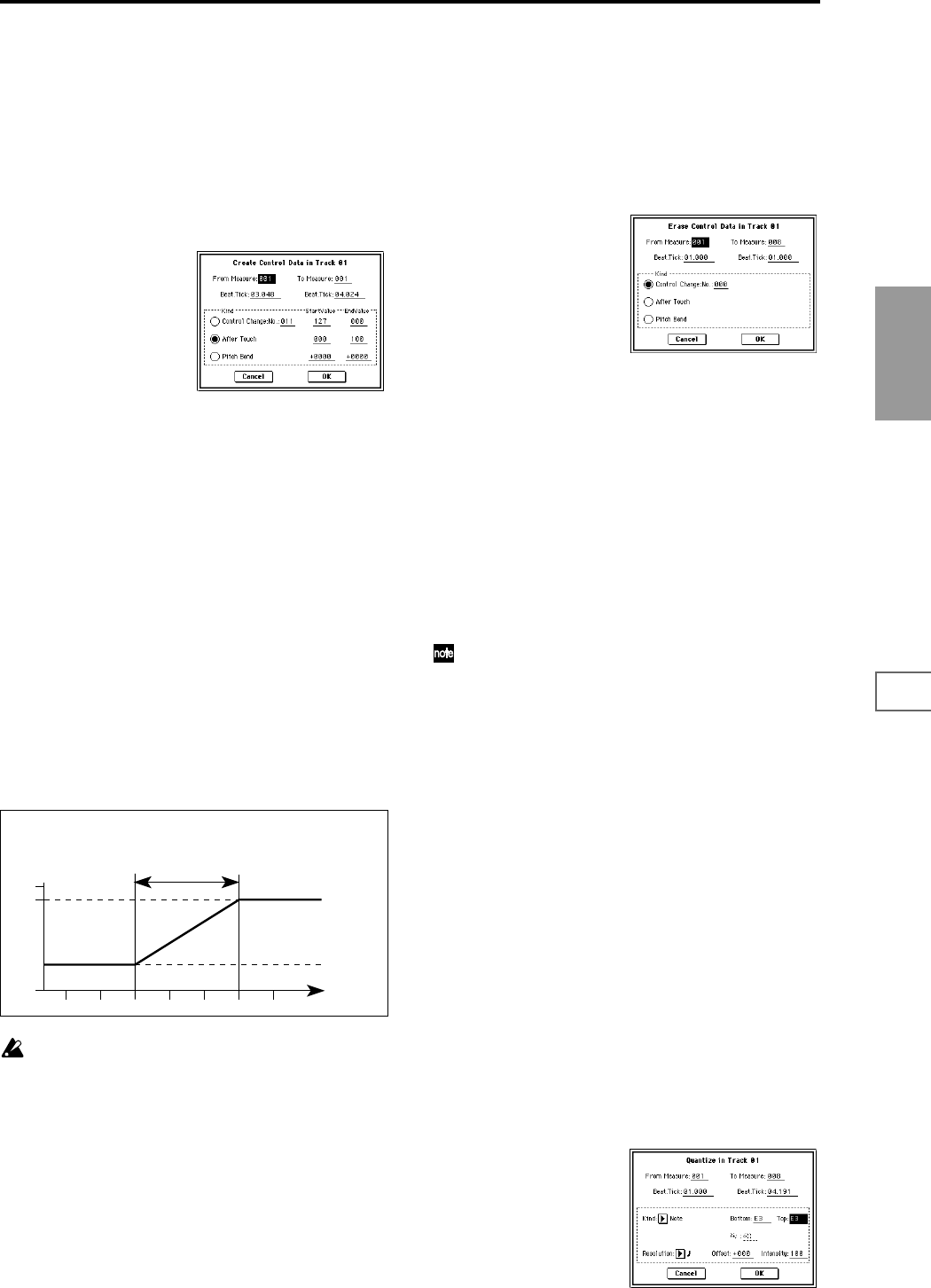
73
Sequencer
P0
P1 P2 P3 P4 P5 P6 P7 P8 P9
5–1L: Create Ctrl Data (Create Control Data)
This command gradually varies continuous-type data (e.g.,
control change, after touch, pitch bend, tempo) in the speci-
fied area.
1 In “Track Select,” select the track on which you wish to
perform the Create Control Data command.
If you wish to modify tempo data, select Master Track as
the track. In this case, the step
4 item “Kind” will be set
to “Te mp o .”
2 Select “Create Ctrl Data” to access the dialog box.
3 Specify the range into which the control data will be
inserted.
In “From Measure” and “To End of Measure” specify
the measures, and in “Beat.Tick” specify the beat and
clock. (By default, “From Measure” and “To End of Mea-
sure” will be set to the range you specified in the Track
Edit page.)
4 “Kind” to the type of musical data (event) that you wish
to create.
Control change: Control change data will be inserted. In
this case, use “#” to specify the control change number.
After Touch: Aftertouch data will be inserted.
Pitch Bend: Pitch bend data will be inserted.
5 In “Start Value,” select the starting value of the control
data. In “End Value,” select the ending value of the con-
trol data. By default, the “Start Value” will be set to the
value of the existing data at the start location. If you wish
to create control data that changes smoothly from the
starting location, you can leave the “Start Value”
unchanged, and set only the “End Value.”
6 To execute the Create Control Data command, press the
OK button. To cancel, press the Cancel button.
When you execute Create Control Data, a large amount
of sequencer memory will be consumed. For this reason
it may not be possible to execute this command if there
is a limited amount of memory remaining. In such
cases, first use “Quantize” (5–1N) to quantize the data
and remove unnecessary control data. Alternatively,
you could quantize the data that was inserted by the
Create Control Data command.
5–1M: Erase Ctrl Data (Erase Control Data)
This command erases data such as control changes, after
touch, pitch bend, or tempo in the specified range.
1 In “Track Select,” select the track from which you wish
to erase control data.
If you wish to erase tempo data, select Master Track. In
this case, the “Kind” item in step
4 will be Te mp o .
2 Select “Erase Ctrl Data” to access the dialog box.
3 Specify the range from which you wish to erase control
data.
In “From Measure” to “To End of Measure” specify the
measures, and in “Beat.Tick” specify the beat and clock.
(By default, “From Measure” and “To End of Measure”
will be the range that was specified in the Track Edit
page.)
4 “Kind” to the type of musical data (event) that you wish
to erase.
Control change: Control change data will be erased. In
this case, use “#” to specify the control change number.
After Touch: Aftertouch data will be erased.
Pitch Bend: Pitch bend data will be erased.
5 To execute the Erase Control Data command, press the
OK button. To cancel, press the Cancel button.
If you wish to erase all control change data from speci-
fied measures, you can also use “Erase Measure” (5–1F)
and set “Kind” to Control Change. However, this Erase
Control Data command allows you to specify the range
using “Beat.Tick,” and also to erase only specific types
of control change data.
5–1N: Quantize
This command corrects the timing of musical data that
already exists in the sequencer. When you execute the Quan-
tize operation, the musical data will be affected as follows:
• When you execute Quantize on note data, the timing of
the note-on will be corrected, but the length (duration of
the note) will not be affected.
• If the Quantize resolution is set to Hi, the timing will be
adjusted to units of the base resolution (/192), so note
data will not be affected. However, continuous
controller data such as joystick or after touch which
occupies a large amount of memory will be processed so
that two or more data events of an identical type existing
at a single interval of the timing resolution will be
combined into a single event, thus conserving memory.
Similarly, two or more data events of an identical type
existing at the identical timing will be combined into one,
also conserving memory.
1 In “Track Select,” specify the track.
2 Select “Quantize” to access the dialog box.
3 Specify the range that will be quantized.
Location
0
3:00 3:24 3:48 3:72 4:00 4:24 4:48
After touch
127
100
Previous data
Start location End location
End Value
Start Value
default value
Example: The controller is aftertouch. Starting location is 3:48, ending location is 4:24,
and end value is set to 100. This will cause the aftertouch value to begin
changing from 3:48, and reach a value of 100 at 4:24.
